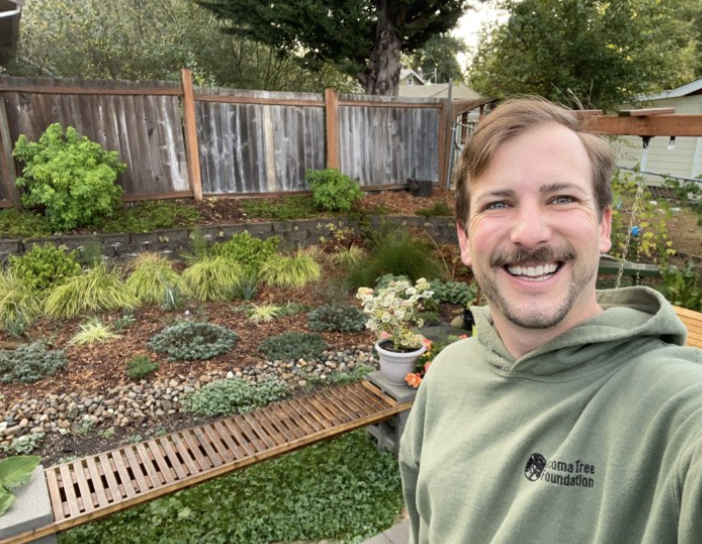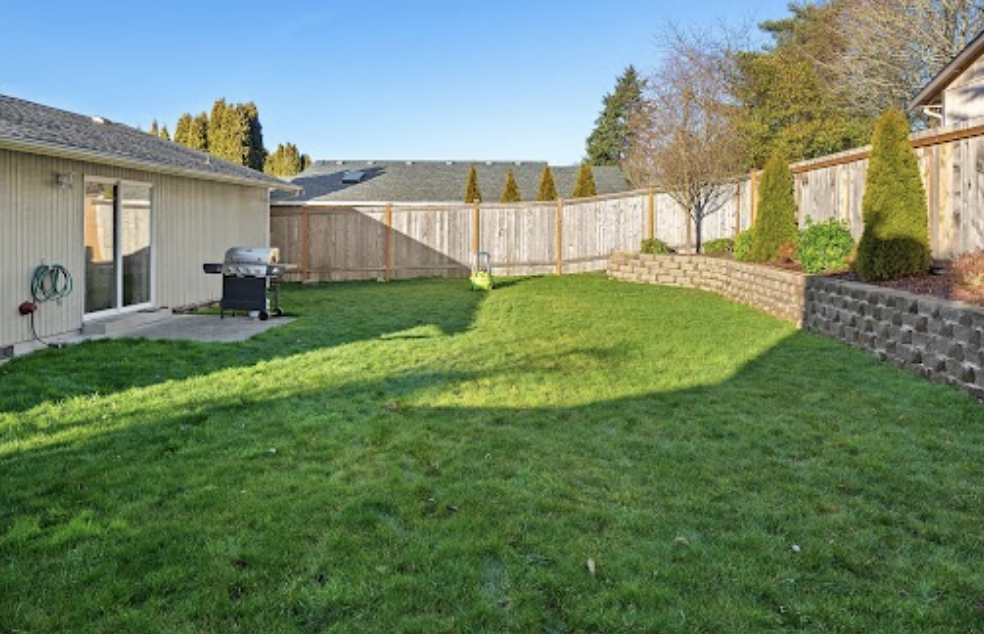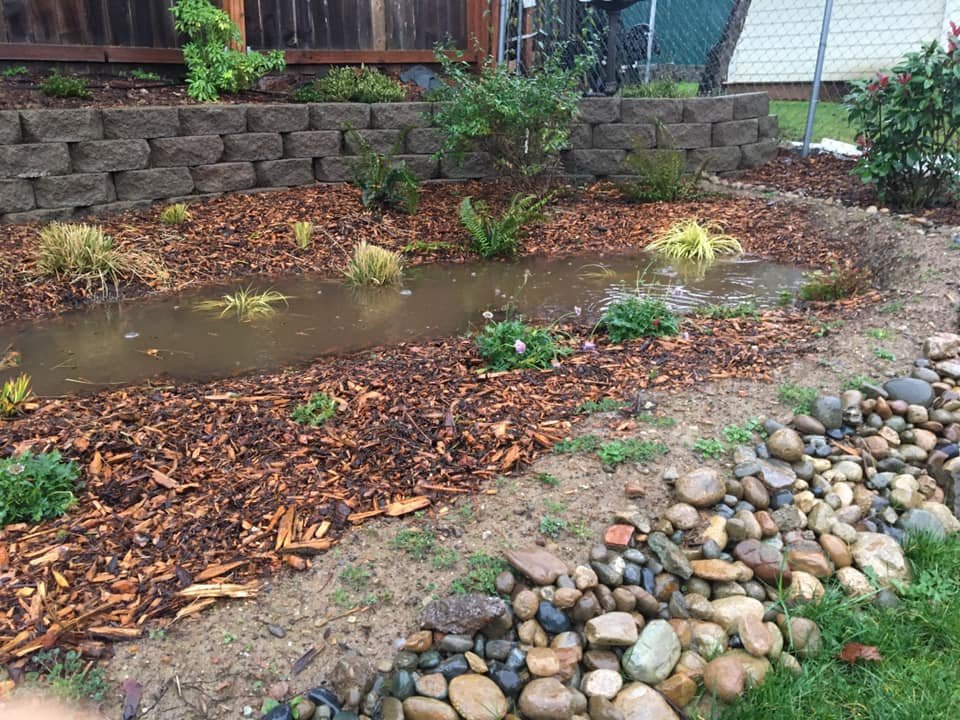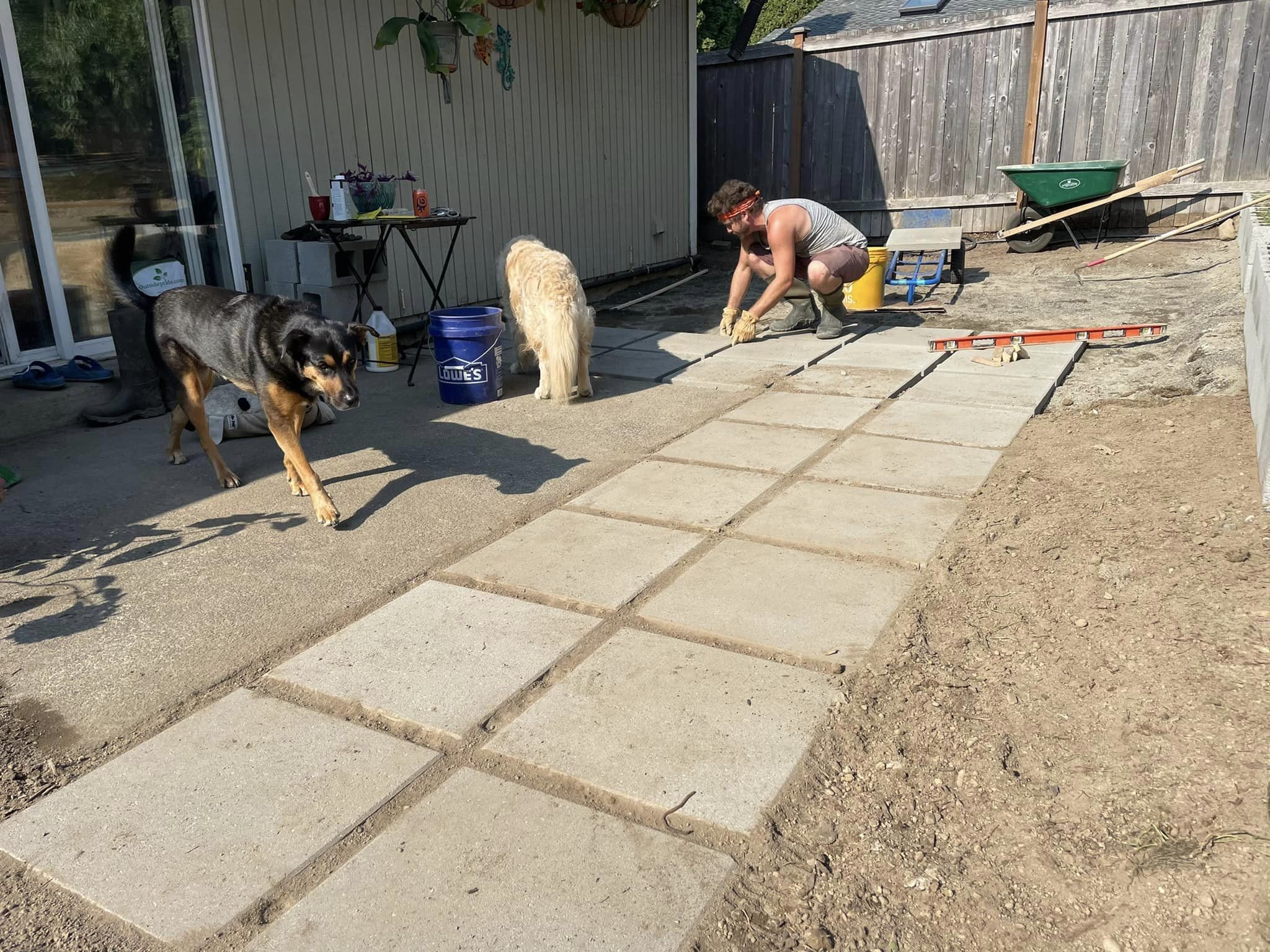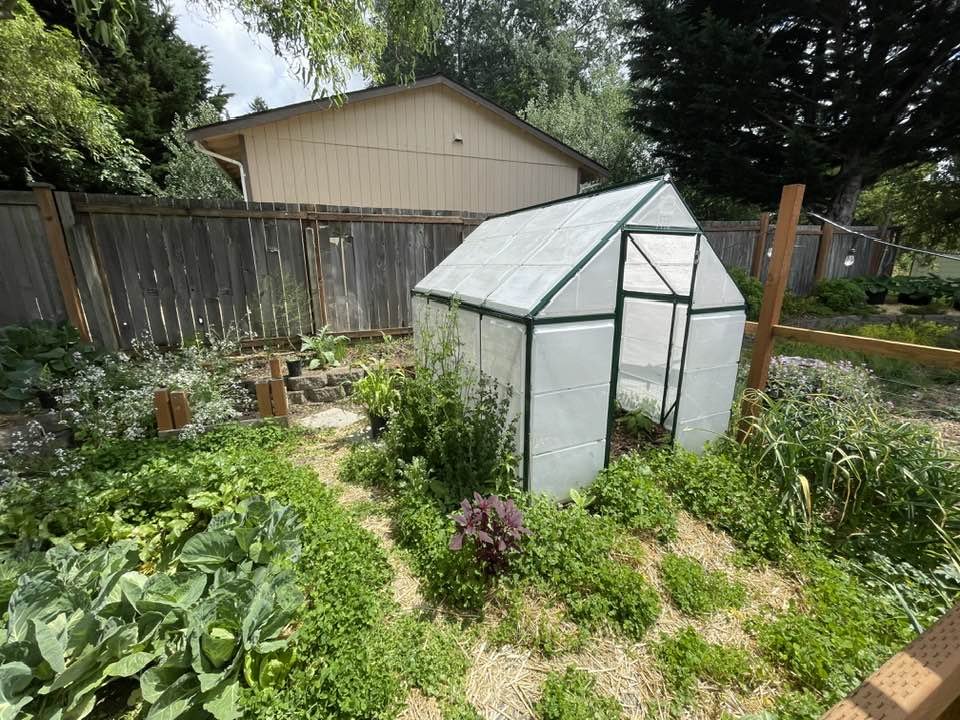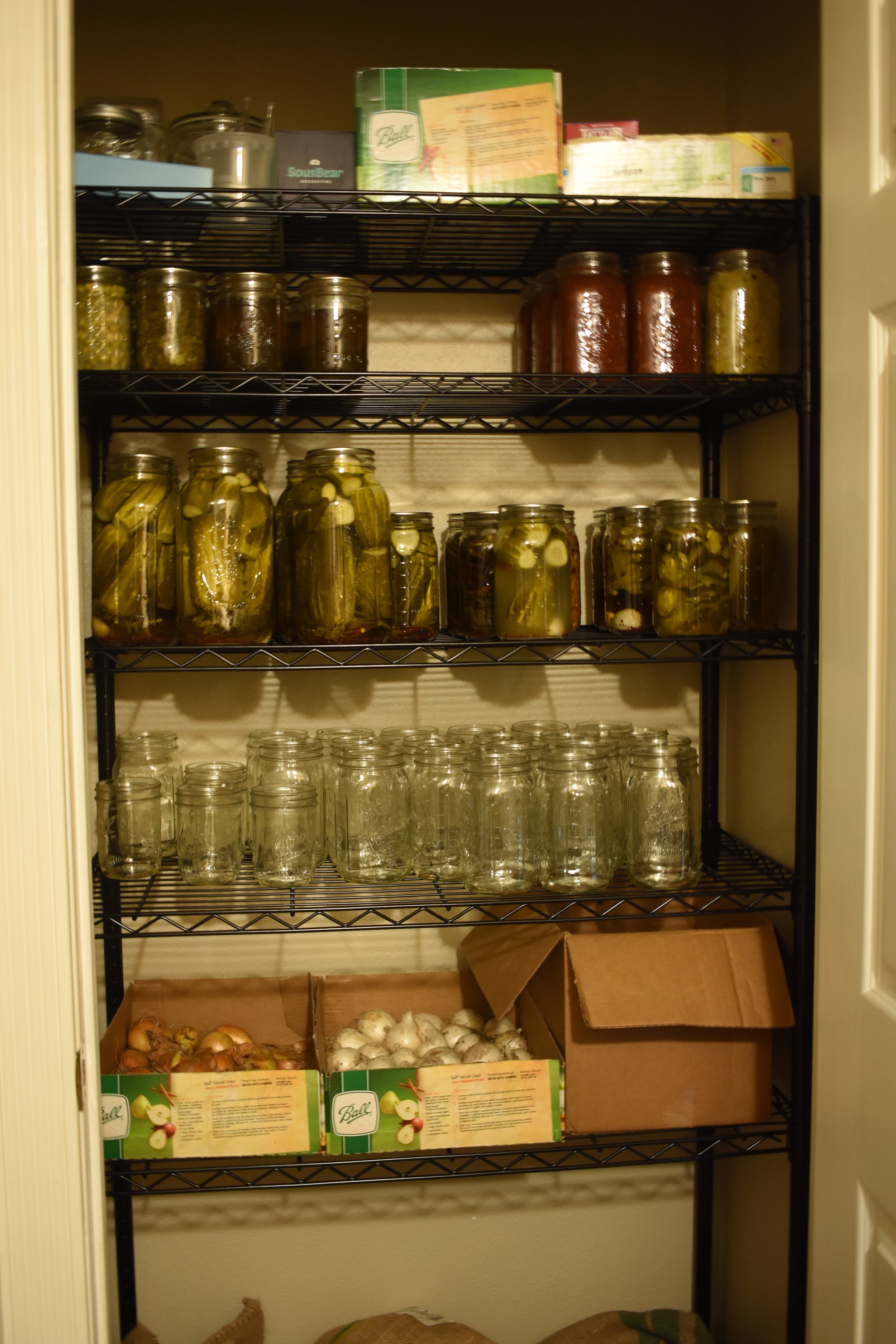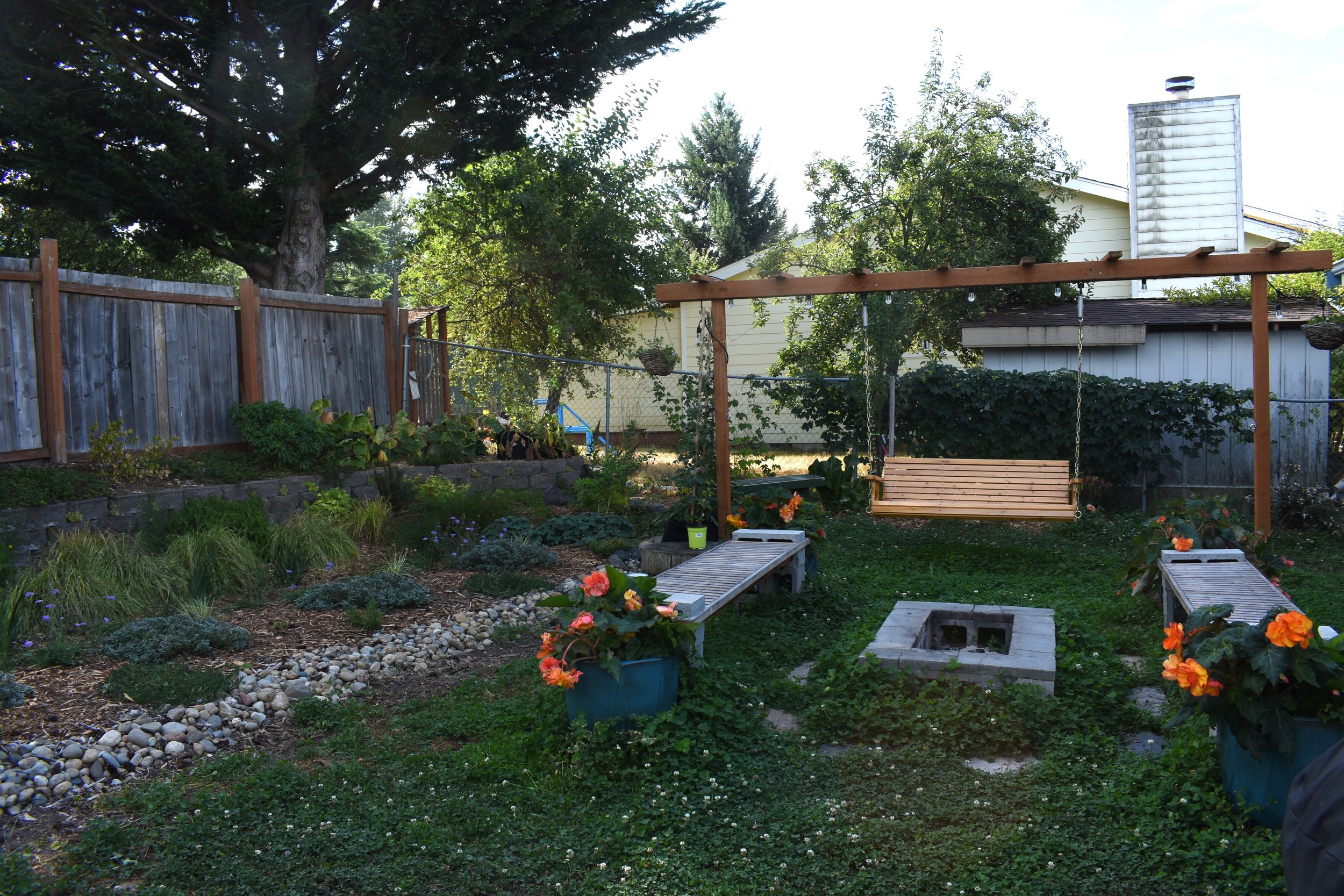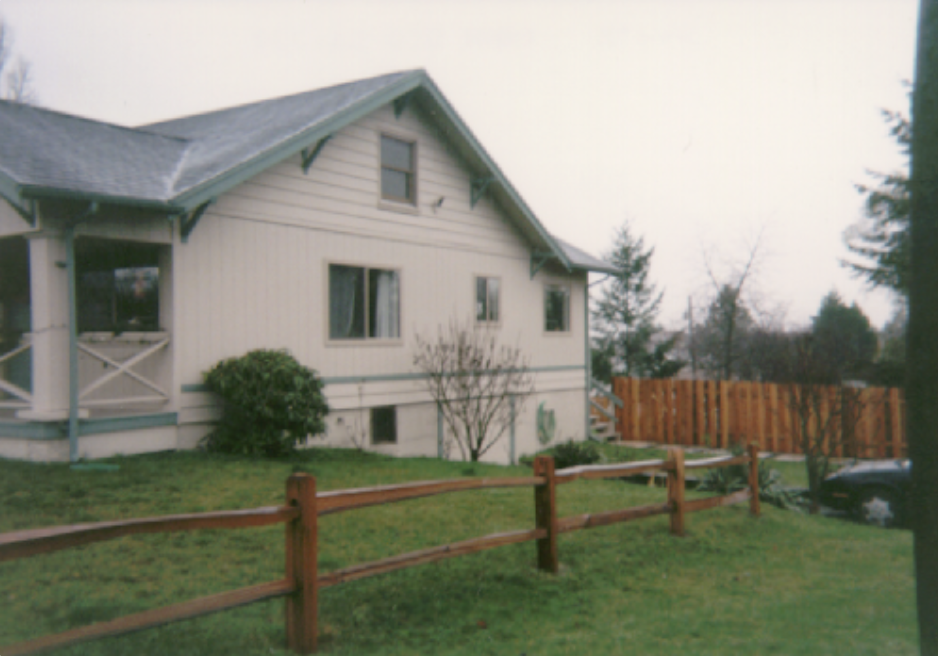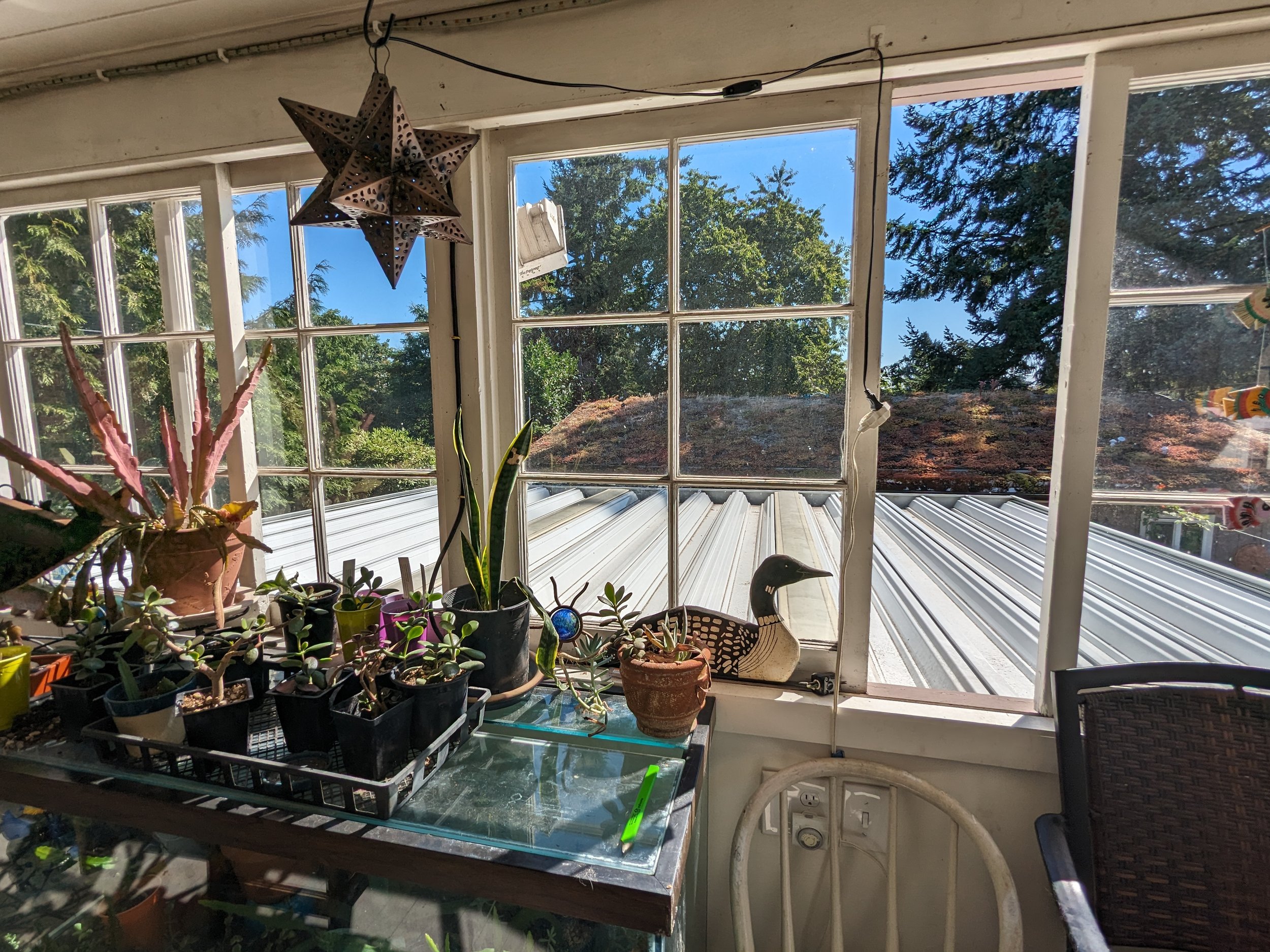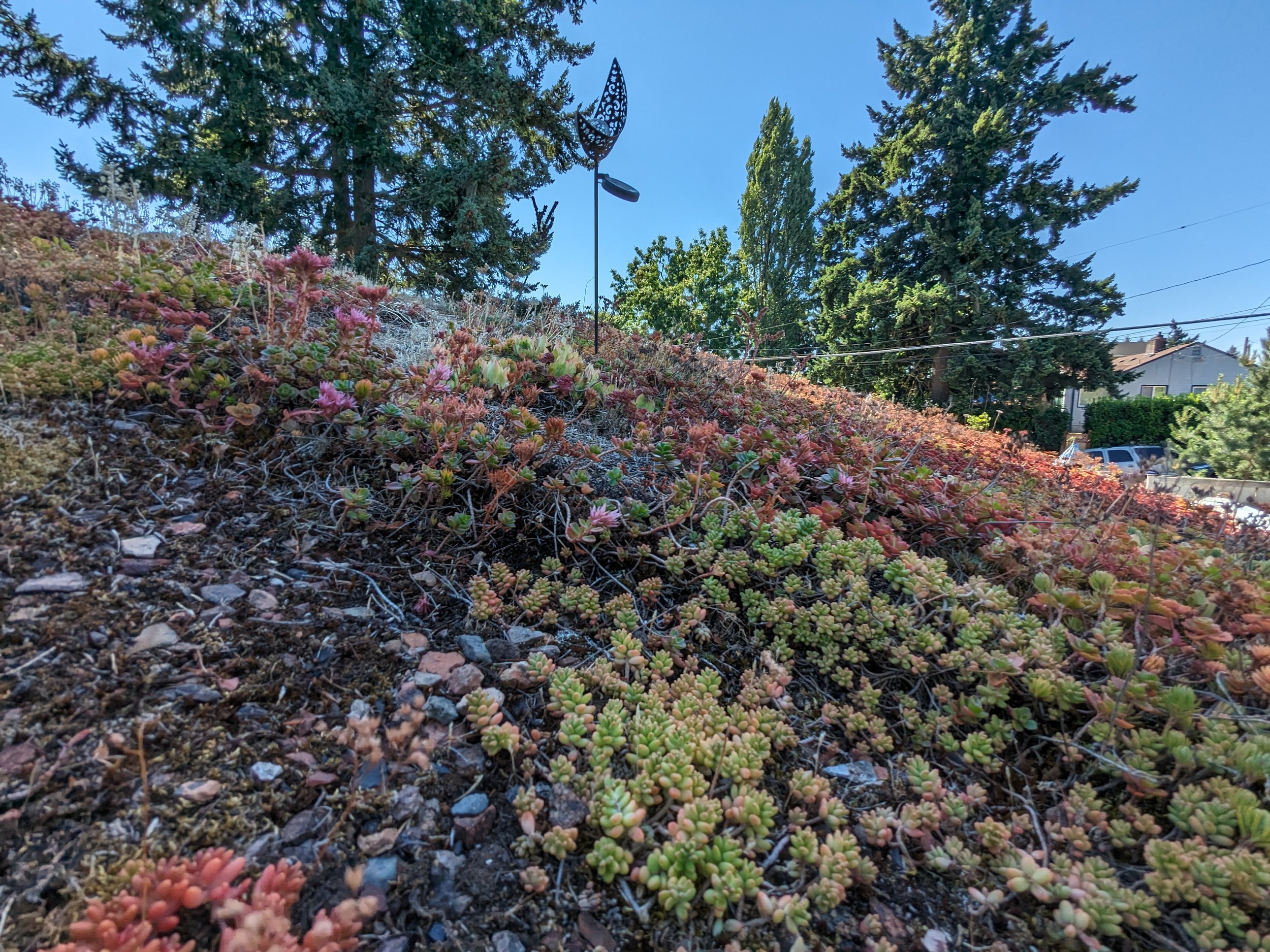On the other side: Why alternative yards are greener.
Take a walk through your neighborhood. Notice how much grass is present: it is in our front yards, the right-of-ways, parks, the landscaping surrounding almost all the buildings. In the United States, grass covers about 40 million acres of land, roughly three times more than any other irrigated crop in our country. How did our landscape become this way? Do grass lawns support the urban forest?
These were the questions on my mind when I met with Robb Krehbiel, currently an environmental planner at Puget Sound Partnership and Tacoma Tree Foundation partner. “I have really, always, hated grass lawns”, he says. I met with Robb on a bright day in August to ask him about the alternative yard he and his partner, Luke, built on their residential property. We are seated at the patio table in his backyard. Under my feet are square stone tiles laid by Luke, the spaces between them filled with green clover. Around us are the other features of Robb’s yard: a rain garden, an edible garden, a firepit overrun by clover, and a hanging wooden loveseat hung from the posts of an arbor. It is an average sized yard for a house in Tacoma, about a quarter of an acre, and Robb has used the space to its fullest–there is not a patch of grass in sight.
When I asked Robb what motivated him to take on his alternative yard project his answer referred to the history of the grass lawn: “It [...] is steeped in the culture of racism and classism and heteronormativity, and that’s all stuff I don’t value.” Sprawling grass lawns were a practice in European aristocratic culture.
Grass was expensive to maintain, often the work was carried out by enslaved people who cut the grass with scythes, making these lawns a physical manifestation of aristocratic wealth, power, and ownership.
Image: Watercolor View of the West Front of Monticello and Garden (1825) by Jane Braddick. Source: Wikimedia Commons.
Following European trends, early American colonists brought turf-grass species over from Europe, integrating it into their estates. Over time, as the U.S. became more urbanized, grass was landscaped onto the yards of almost every residential property in the country. Through the ideal of the white picket-fence house, grass lawns came to represent the values of the American dream, gender norms, racial divisions of labor, classism, and colonial appropriations of stolen land. Further, the prescriptive standards around lawn maintenance have brought fines and even jail time for some elderly folks physically unable to care for their lawns, as in these examples, demonstrating how lawn policies are ableist. Though, perhaps more familiar to most of us are the numerous studies that have uncovered the detrimental impacts of lawn pesticides and maintenance tools on the environment, wildlife, and human health.
Coupling this scientific evidence with the social and cultural history of grass lawns, many now see them as symbolic of environmental injustice. To cultivate environmentally just outdoor spaces, people are designing alternative yards and approaches to landscaping based on ideas of care, community, and support for ecological and human well-being. Depending on the design, alternative yards can provide the benefits of restoring native ecology, providing pollinator habitat, and reduce maintenance demands, stormwater runoff, pesticides, polluting maintenance tool use, and local effects of climate change. In addition they support the health and growth of the urban forest by boosting the ecological diversity of an area, which protects against disease, and can re-green spaces where a tree may not be appropriate, such as near underground piping or in small spaces.
Alternative yards often include clever space and waste solutions, as on Vivian deZwager’s green roof. Vivian is a TTF board member, Pierce County Master Gardener, certified arborist, professional horticulturist, and landscape designer. In our interview, while sitting in the garage that she and her husband built, she shares the evolution of her alternative yard project, which started by building a patio and garage, and evolved into the building of a green roof, and planting several multipurpose garden beds. Vivian’s yard, like Robb's, is average size for a house in Tacoma, with the garage taking up a back corner. “It wasn’t until we put the walls up that I was sitting in the house and realized I would be looking at shingles all the time.” From there, they had the garage re-engineered to hold the green roof. “It was all for the aesthetics… But the benefits of the green roof far outweigh the aesthetics of it.” Vivian describes watching a Junco build her nest by taking pieces of foliage from the green roof last spring, and noticing the volume of bugs and bees enjoying the space.
Vivian’s garden was built through her passion for plants, especially conifers. “I’m a big conifer geek .” Like most of the plants in her garden, her favorite, the Wissel’s Saguaro Lawson Cypress was something that caught her eye when she worked at a plant nursery: “I would see all the plants that were coming in and I was like Oh! I have to have that, and that one.” Walking through her yard I noticed the eclectic blend of rare conifers, native shrubs, and bright flowers, each chosen by Vivian as she found more and more plants that inspired her; I appreciated how her garden is an expression of her creativity, and a place that supports her own well-being.
The first thing that Robb did to support his own well-being was build a rain garden: a low space in the yard sectioned off by berms on all sides and covered in plants, where stormwater runoff from the roof is funneled via an underground pipe, filtering through the plant’s root systems, before returning to the groundwater. This project was one of the most important to Robb, both because the structure of his house makes his basement prone to flooding, and because having previously worked as Pierce Conservation District’s green stormwater program manager, he knows the damage stormwater runoff wreaks on the Puget Sound’s ecosystem.
Within the rain garden, Robb has planted what he tells me is his favorite native plant, camas, which attracts pollinators in the spring, boosting the ecological diversity and health of his garden. He tells me a little bit of the history of camas and colonialism in the area and his previous work with different tribal leaders.
Through learning about Indigenous culture and growing camas, Robb has found a meaningful way to both acknowledge the violent history of the land he lives on, and find a starting place for healing the cultural and ecological wounds left behind: “The camas bulb is not just a pretty flower to me it is also a way that I try to honor that history”.
Another way Vivian has found she can care for herself is by practicing what some might call “lazy gardening.” To Vivian this means letting herself keep an unperfect garden. She tells me that while working as grounds maintenance for Tacoma Power there were people who valued the “vacuumed, neat and tidy” aesthetic for the properties they maintained, meaning removing all dropped leaves from the ground and keeping everything pruned. Vivian, and many others understand this approach as harmful, as it essentially sterilizes the environment, leaving little space for creatures who rely on fallen leaves and fuller shrubs and trees for habitat. Pressures to produce this type of aesthetic came both from Vivian’s coworkers, and others who would see her home garden space. After taking continuing education classes at Tacoma Power, which promoted supporting local ecology through the maintenance practices, she felt empowered by her decisions: “Now I can reframe, and it’s like no, that's a really nice habitat for other things, it's not for my aesthetics necessarily.” Vivian explains that while existing research supported her choices, it was still difficult to assert herself in the face of those social pressures. She struggled with this for a long time. Now retired from her job at the city, she has accepted that she doesn’t “need to dump a whole bunch of time into my garden to make it presentable or for it to be enjoyable.” She continues to practice imperfect gardening because “not having it perfect benefits a lot of other things.”
“Not having it perfect benefits a lot of other things.”
From first to last: Robb’s yard pre-transformation; rain garden in action; Luke laying the stone patio tiles; Robb’s edible garden; Robb’s food stores; Robb’s rain garden and arbor; Vivian’s yard pre-transformation; the view from Vivian’s back porch window onto the green roof; Vivian on the green roof; Vivian’s outdoor living room; Vivian’s green roof; Vivian’s other favorite conifers.
This is the moral of the story with alternative yards: not having it perfect benefits a lot of other things. By avoiding the harmful social and cultural standards of the “perfect” yard, whether this means eliminating grass or avoiding the usual approaches to yard maintenance, Robb and Vivian have found new and innovative ways to benefit the social and ecological ecosystems surrounding them. For Robb, his yard is “[a] way of rejecting all that [harmful practices] and embracing my own queerness here in this space and embracing diversity, and re-situating my orientation to how I see the world.” For Vivian it’s about creating a space that’s hospitable to both humans and other creatures, she says it “does make my heart real happy” when she sees animals and humans enjoying her space.
For the urban forest, alternative yards are an important way that individuals and their families can help improve and sustain the health of the urban forest without necessarily planting trees, making it a more accessible option for many in the Puget Sound area who may be limited by space or other restrictions.
All photos in this essay, unless otherwise noted, were taken by Eden Standley and are shred with permission of our generous partners, Robb and Vivian.
Feeling inspired? Whether you are a property owner, renter, or just have a porch, we’re here to support you! There is something in this list for everyone: take a look at TTF’s guide to creating your own alternative yard below.
Planning an Alternative Yard
Goals: It will be helpful to identify what is motivating you to reshape your yard: Is it about taking action against climate change? Building more just domestic or community spaces? Creating an outlet for creativity and self care? With this, choose the features you’d like your yard to include according to your goals. Each alternative yard has its own benefits.
Survey: What are the existing features of your yard now? Do you have grass or plants you would like to take out? Existing plants you would like to keep? Are there spaces where there is poor soil drainage or where nothing seems to grow? Does your yard contain any concrete you would like removed or that you would need to work around? These are all things to consider before moving forward with planning.
Budget and Timeline: Robb and Vivian estimated that they spent a couple thousand dollars or more, plus their personal time to create their yards, and while Robb has been working on his yard for 6 years, Vivian’s has been almost a 30 year project. It is important to set a realistic budget and timeline for yourself. For example, if you are thinking about implementing more expensive features, maybe plan for a longer timeline (and take a look at the mini stormwater grant linked below!). Or, as Vivian recommends, identify a small project that is feasible in a short amount of time and little money and branch out from there.
Resource List: When I asked Vivian and Robb what kinds of people would be best suited to have yards like this, they said everyone! Remember that no matter who you are, or your situation, there is an accessible way for you to get closer to nature, and there are people who want to help you do that.
There are many cheap resources for developing an alternative yard, some that Robb and Vivian recommend are:
Join Chip Drop, for free arborist wood chips delivered to you.
Learn to propagate plants! We have a great article on how to propagate hardwood cuttings.
Apply for the Mini Stormwater Grant through pierce conservation district, which can help fund your entire alternative yard project as long as it supports better stormwater runoff management. Applications are due in November.
See this in-depth guide to building a rain garden from Washington’s department of ecology
Check in with local schools, many do native plant sales as fundraisers throughout the year.
Check in with other places that do native plant sales, such as Pierce Conservation District, or Master Gardener Foundation in Pierce County.
Request free trees through TTF’s Branch Out program, applications are due October 15th, or request a tree through Grit City Trees, they accept applicants in late summer.
See the American Horticultural Society’s website, which has links to many good resources and gardening tips to help support you, or the WSNLA’s website, which also has great resources and can help you find a certified professional if needed.
See this native plant guide for the PNW with filters to sort for the kinds of plants your space needs.
For small space gardening solutions, this article from Penn State may help provide solutions.
Starting Small
If you are feeling overwhelmed, Vivian and Robb’s have this advice:
Getting Started: If you have trouble starting your garden, Vivian recommends buying potted outdoor plants and enjoying them like bouquets of flowers, as this will help you learn when they need watering or tending to.
Maintenance: Consider that there will be more maintenance work in the beginning stages of your yard or garden, but less as the plants settle in and mature. There will however, always be the need to water and weed. Robb recommends finding a time that is best for you, grabbing your favorite drink (he prefers after work, with a beer), and taking a walk through your yard, at least every few days, hand weeding as you see small weeds pop up, and watering This low stress approach to maintenance catches weeds before they get too big and can be a good mindfulness practice
Take Chances: Lastly, Vivian wants everyone to know “Don’t be afraid to try something, don’t be afraid to bring a plant home. And it’s okay, plants die, they do.” Take the pressure off of yourself to keep all your plants alive and perfect. Instead, be a scientist: take note of where certain plants thrive and die and try to consider why. Robb told me it took him a while to figure out what would grow where in his yard due to soil and light differences. It was especially difficult for him to find something that would grow in the spot he deemed “the corner of death”, but he kept trying, replacing plants as they died, and eventually he found the right ones for the right spaces. You will, too!
We are grateful for Robb Krehbiel‘s and Vivian deZwager’s generosity and willingness to share their time, space, and gardening wisdom.




